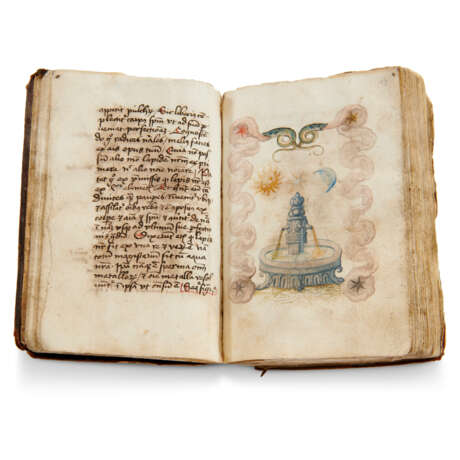ID 794381
Лот 40 | Pseudo-Arnaldus de Villanova et al.
Оценочная стоимость
£ 4 000 – 6 000
Compilation of alchemical texts, in Latin and German, illustrated manuscript on paper, [Austria, possibly Schwaz] 1529, [and c.1600].
A fascinating alchemical miscellany, including an early, dated, manuscript witnesses to the famous Rosarium philosophorum, compiled here by the Tirolese alchemist and humanist Michael Cochem in 1529.
157 x 105mm. 114 + i leaves, collation: 18 (of 10, i and x cancelled blanks), 27 (of 8, lacking ii), 37 (of 8, lacking ii), 46 (of 8, lacking ii and vi), 58 (of 10, lacking iii and x), 66 (of 8, lacking ii and vi), 76 (of 8, lacking ii and vi), 86 (of 8, lacking ii and vi), 96 (of 8, lacking ii and vi), 106 (of 8, lacking ii and vi), 116 (of 8, lacking iii and viii), 127 (of 8, lacking vi), 137 (of 8, lacking iv), 147 (of 8, lacking ii), 15-178, 186 (of 8, vii and viii cancelled blanks), modern foliation in pencil followed here, the earlier 16th-century section ff.1-86 with 17-20 lines of text, large initials and rubrics in red, capitals touched in red, the later German section with 18-19 lines of text, signatures for illustrations survive, one full-page illustration for the Rosarium philosophorum (lacking all but one of the illustrations for the Rosarium philosophorum, some foxing and staining, especially to opening leaves, some thumbing). Contemporary Germanic blind-stamped calf over very thin pasteboards (worn and cracked, especially on spine).
Provenance:
(1) Michael Cochem, 16th-century humanist and alchemist, his autograph colophon on f.83v: ‘Explicit libello Rosella ph[ilosoph]orum i[n]titulata. Et unum per me Michaele[m] Coche[m] collectus atque appositus. Et scripta anno salute hu[m]ane 1529 Lucie virginis. De quo sit b[e]n[e]dicta s[an]cta dei t[ri]nitas. Amen. Amen’. Little is known about Lochem, but a small number of alchemical texts datable from 1522-1533 written and owned by him can be found in St Gall (Bibliothek Vadiana, MSS 403 and 430), and it is from one of those manuscripts that we know he was from Schwaz, Austrian Tyrol (on Cochem, see U. Gantenbein, ‘Das Kunstbuch des Michael Cochem [Ms. Vadiana 407] aus dem Jahr 1522. Seine Bedeutung für die medizinische Alchemie‘, Mitteilungen der Fachgruppe Geschichte der Chemie der Gesellschaft Deutscher Chemiker 15, 2000, pp.32-61).
(2) B. Magnus ?Fässle of the Benedictine Abbey of Monte Maria (Marienberg), near Malles, in Val Venosta, Italy: ownership inscription on f.1: ‘Possessor B. Magnus Fässle? Profess[us] Marie Montensis in Tyroli Ord. S. Benedicti, 1600’.
Content: Lapis philosophorum, or ‘Lapis hic ph[ilosoph]orum vere’, beginning ‘Si felicitari desideras ut benediction[n]em ph[ilosoph]or[um] obtineas […], ff.1-1v; ARNALDUS DE VILLANOVA (c.1240-1311) ‘Epi[isto]la Arnoldi de novavilla ad rege[m] Neapolitanu[m]’, beginning: ‘Scias o tu rex q[uod] sapie[n]tes posueru[n]t ff.2-7’; blanks ff.8-9; PSEUDO-ARNALDUS DE VILLANOVA, Rosarium philosophorum, or, here, ‘Rosella Philosophorum’ beginning: ‘Qui desidera[n]t artis phi[losophi]ce scie[ntie] maioris cognition[n]em’ ff.10-83v; blanks ff.84-86; German treatise on the alchemical process ff.87-114: on the preparation of the Philosophers’ stone from Antimony (f.87), on the calcination of lead (91v), the extraction of Cypriot sugar (f.92), its purification (93) and fixation (f.96v), and subsequently incineration (f.104v), trituration (the reduction of substances to a powder) and projection (in which the stone or elixir is tossed upon the molten base metal - lead or tin, in this case - to transmute it).
The text of the Rosarium in the present manuscript matches that of the Rosarium attributed to Arnaldus de Villanova, medieval physician, religious reformer, astronomer and alchemist (see another, unillustrated, copy in the National Library of Israel, Ms. Ed. 13, similarly dated to the first half of the 16th century). The text, which describes the preparation of the Stone, would provide the foundation for the hugely influential 1550 Frankfurt publication of the Rosarium Philosophorum in De Alchimia Opuscula complura veterum philosophorum. The illustrations (which would appear in the 1550 edition as a series of 20 woodcuts with German language captions) appeared in various alchemical works throughout the 15th and 16th centuries (for example in the Buch der heiligen Dreifaltigkeit of c.1410), and one exquisite one survives in the present manuscript.
The illustration on f.13 depicts the alchemical fountains, the six-pointed star, the Sun and Moon, and the two-headed dragon. The fountain pours forth the three substances that supposedly flow from the centre of the soul – 'Lac Virginis' (the Virgin's milk), 'Acetum fontis' (the spring of vinegar) and 'Aqua Vitae' (the water of life). The latter represents the force within man, whereas the other two represent a contribution from both the feminine, receptive, lunar forces, and those of the penetrating, sharp, solar male. These mingle and mix in the lower part of the soul - the fountain's basin, and the substance created is known as the water of Mercury. The latter stages of the alchemical process take place in these waters.
Special notice
No VAT on hammer price or buyer's premium.
| Место происхождения: | Австрия, Западная Европа, Европа |
|---|---|
| Категория аукционного дома: | Манускрипты Средневековья и Ренессанса, Медицина и наука |
| Место происхождения: | Австрия, Западная Европа, Европа |
|---|---|
| Категория аукционного дома: | Манускрипты Средневековья и Ренессанса, Медицина и наука |
| Адрес торгов |
CHRISTIE'S 8 King Street, St. James's SW1Y 6QT London Великобритания | |
|---|---|---|
| Предосмотр |
| |
| Телефон | +44 (0)20 7839 9060 | |
| Комиссия | see on Website | |
| Условия использования | Условия использования |





